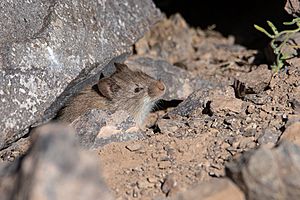White-bellied grass mouse facts for kids
Quick facts for kids White-bellied grass mouse |
|
|---|---|
 |
|
| Conservation status | |
| Scientific classification | |
| Genus: |
Akodon
|
| Species: |
albiventer
|
| Synonyms | |
|
berlepschii Thomas, 1898 |
|
The white-bellied grass mouse (Akodon albiventer) is a small rodent that belongs to the family Cricetidae. This family includes many types of mice and hamsters. You can find this mouse living high up in the Andes mountains. Its home stretches from southeastern Peru to southwestern Bolivia, northwestern Argentina, and a small part of northeastern Chile. These mice live in very high places, from about 2,400 meters (7,900 feet) to over 5,000 meters (16,400 feet) above sea level.
Contents
What is the White-Bellied Grass Mouse?
The white-bellied grass mouse is a type of mouse known for its light-colored belly. It is also called the white-bellied akodont. These mice are part of the Akodon genus, which includes many species of grass mice found in South America. They are well-adapted to living in the cool, high-altitude environments of the Andes.
Where Does This Mouse Live?
This mouse lives in the Andes mountain range. This huge mountain chain runs along the western side of South America. The white-bellied grass mouse prefers the high parts of these mountains. It can be found in several countries:
- Peru (southeastern parts)
- Bolivia (southwestern parts)
- Argentina (northwestern parts)
- Chile (far northeastern parts)
These areas are known for their unique plant life and often cold weather. The mouse has adapted to these tough conditions.
How High Do They Live?
The white-bellied grass mouse is a true mountain dweller. It lives at very high elevations.
- The lowest elevation where they are found is around 2,400 meters (about 7,900 feet).
- They can live as high as over 5,000 meters (more than 16,400 feet).
To give you an idea, 5,000 meters is higher than many famous mountain peaks around the world! Living at such heights means they can handle thin air and cold temperatures.
What Do White-Bellied Grass Mice Look Like?
White-bellied grass mice are small rodents. They have fur that helps them blend into their environment. Their most notable feature is their white or light-colored belly, which gives them their name. Like other rodents, they have strong front teeth that grow continuously. These teeth are perfect for gnawing on plants and seeds.
What Do They Eat?
As "grass mice," their diet mainly consists of plants. They likely eat:
- Seeds
- Grasses
- Other plant parts
Their diet helps them get the energy they need to survive in their cold, high-altitude homes.
Life Cycle and Behavior
Not much specific information is widely known about the exact life cycle and daily behaviors of the white-bellied grass mouse. However, like most small rodents, they likely:
- Are active at night (nocturnal) to avoid predators and extreme daytime temperatures.
- Live in burrows or sheltered spots to stay warm and safe.
- Have a relatively short lifespan, typical for small mammals.
Reproduction
Rodents generally reproduce quickly. Female white-bellied grass mice likely have several litters of pups each year. This helps them maintain their population numbers. The young mice grow quickly and become independent.
Conservation Status
The white-bellied grass mouse is currently listed as "Least Concern" (LC) by the IUCN. This means that their population is stable and they are not considered to be at high risk of extinction right now. This is good news for this little mountain dweller!
Why is "Least Concern" Good?
When an animal is "Least Concern," it means:
- There are many of them.
- Their habitats are generally safe.
- They are not facing major threats that could make their numbers drop quickly.
However, scientists continue to monitor all species to ensure their long-term survival.
Images for kids
See also
 In Spanish: Ratón de hierba de vientre blanco para niños
In Spanish: Ratón de hierba de vientre blanco para niños



